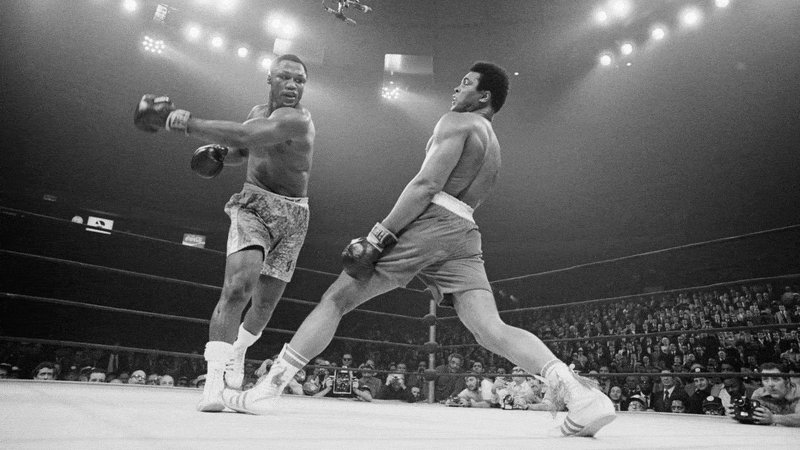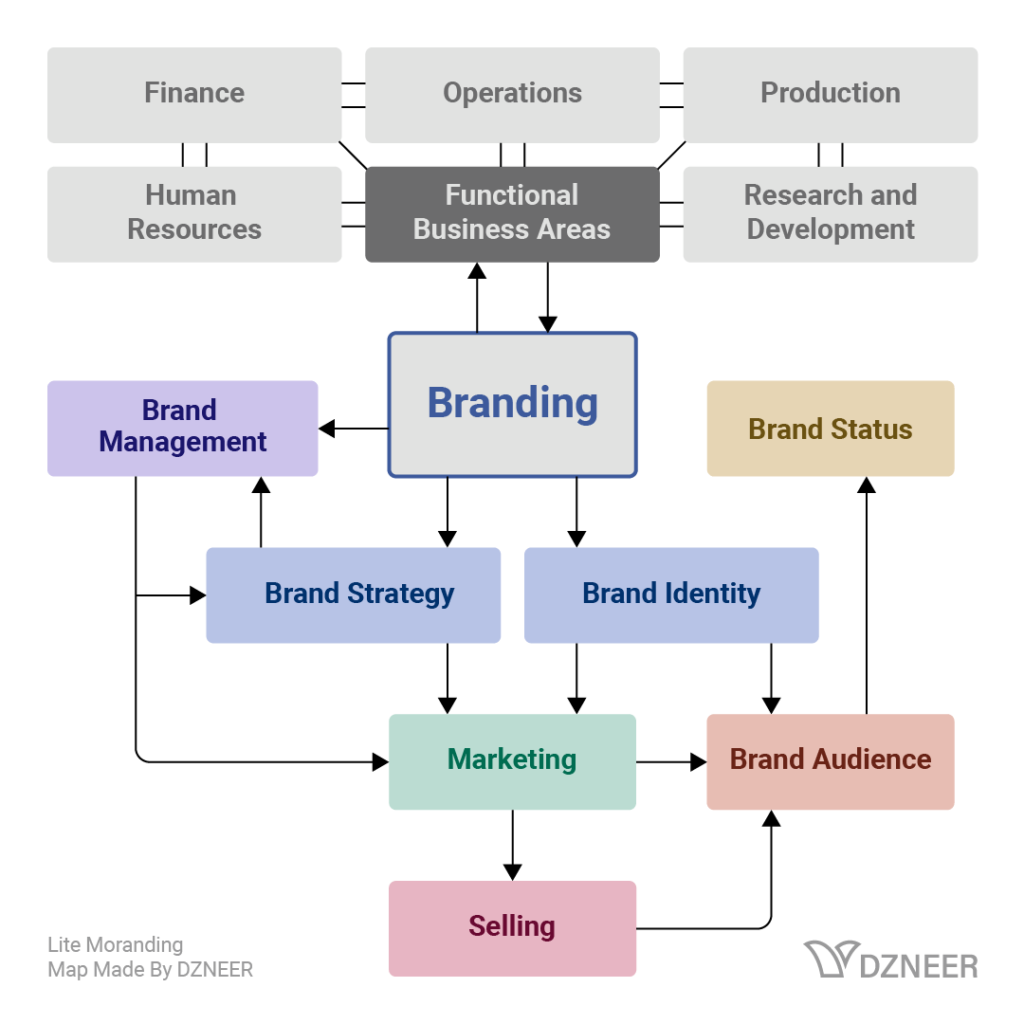Introduction: This article was written by Omar Salman and it is considered a new introduction to the science of branding, and gives comprehensive definitions of the terms brand and branding, and explains the differences and boundaries between marketing and branding and the correct positioning in the company departments.
What is the correct definition of brand?
What is A brand? brand is an entity with culture, purpose and reputation
If all these parts exist, this entity becomes a brand, it can be a person, a company, a non-profit organization, a state, a community
Brand Elements
- Culture: form, behavior, sound, principles, practices, language, identity.
- purpose: the reason that causes the subject to perform the action.
- Reputation: public general impressions and people’s perceptions of an entity.

Example: Personal Brand Of Muhammad Ali Clay
The Culture
- Shape: The handsome black African man often appears in boxing trunks, and in meetings in an elegant black suit, and there is no tattoo on his body.
- Communication voice: He was telling the truth clearly and boldly, moving hearts, stimulating and inspiring minds, adding a humorous character to his speech.
- Values and Principles: Islam was the source of its values such as Honesty, sacrifice, altruism, charity, integrity, fairness, justice.
- Personality: Athletic, solid in character, courageous, He works by his values and fights to preserve it.
Reputation
Before the arrival and spread of the Internet, Muhammad Ali’s legendary status extended to all parts of the world as a result of his intellect, beliefs, and the power of his muscles. In addition to boxing tournaments and his political activity.
Purpose
Preparing himself to meet God and enter His Heaven by obeying Him and worshiping Him in the manner He pleased – and dedicating his name and fame to helping make peace in the world and a fight for justice.
What is the correct definition of branding?
Branding is harnessing psychology and sociology in making a strategic approach and applying it through the five sensory media to consciously influence the behavior of the brand’s audience in order to achieve goals.
Note: Brand audience includes customers, potential customers, employees, investors, stakeholders
Branding uses: companies, institutions, people, countries, non-profit organizations, video games, applications, series and movies, communities.
Each use in a particular field has some sections and special methods in developing and applying the psychological method, but in this article we will focus on the commercial aspect more precisely.
Branding was not invented but revealed: Branding has been around since God’s first creation for humans, God placed the instinct in the infant, he gave the infant the innocent appearance and the screaming voice in order to make his parents meet his needs as soon as possible, If his crying was like the crying of adults, his voice would be low and would not become confusing to his parents to meet his needs as soon as possible.
How did branding science appear: branding science It is a science derived from psychology and sociology, neuromarketing, behavioral economics, public relations, it began to form after practices that were developed in various fields in order to achieve the most famous goals: selling, addiction, motivation, changing the mental image, fame and discrimination.

What is the difference between branding and brand?
The difference between branding and brand is: Branding is an artificial, systematic interaction in order to reach a goal that requires interaction with a specific audience. As for the brand, it is an entity that has a culture, a purpose, and a reputation, and it is not required to have a method to influence the behavior of the audience, but rather it may be dealing with its nature to achieve its goal, regardless of whether its method is effective or not.
What are the elements of branding?
Branding is divided into two parts, the first section is brand building, a section that is done by the branding agency in cooperation with the company in some steps and is divided into two parts (brand strategy + brand identity), and the second section of branding is brand management and this section becomes the responsibility of the company after adapting the team.
Brand building
Brand Strategy (Brand Ambitious Soul)
Brand strategy is the soul, compass, and map to reach your goal and purpose, and it is based on psychology and sociology, to study specific groups of people with common characteristics, or situations and is analyzed in depth to develop a systematic plan to influence their behavior effectively.
“You may reach your goal without a strategy, but then you will have spent a lot of money and time. That is if you survive in this chaotic world full of competition.”
Omar Salman
Brand Strategy include:
- Brand Story: A story developed to create content that emotionally connects with customers
- Brand Positioning: a plan for positioning the brand in the mind of the brand’s audience
- Brand Architecture: A strategy for effectively arranging entity multiple Brands
- Brand Promise: A sentence that tells customers what they will get by interacting with the Brand
- Brand Personality: the characteristics of the brand that will interact with Brand audience
- Brand Core value: The values the brand operates with toward the brand’s audience
- Brand Vision: An inspiring, motivating description of what the brand wants to achieve in the long run
- Brand Mission: Description the activity you are currently undertaking to achieve the brand’s vision
- Brand Culture: Principles and guidance for how the brand’s audience interacts with each other
- Brand Purpose: process of understanding the purpose of creating brand and what will distinguish it
- Brand Activation: A process for publishing and implementing a Brand after it has been Rebranded
- Brand Objectives: a map of the standards to be reached to achieve the brand’s vision
- Loyalty Systems: systems developed to motivate customers to continue interacting with the brand
- Progress Criteria: criteria for measuring a brand’s progress, how close it is to achieving its goals/vision
Brand identity (interacting brand body)
The brand identity is the external body of interaction and implementation of the strategic approach through the five sensory media (visuals, tastes, acoustics, smells, taste) and every element within the sensory identity of the brand (the brand) has opportunities to make a significant impact and create competitive advantages, This makes marketing very effective and improves brand status.
Brand identity is not only a sensory means of identifying an entity but also of presenting an integrated experience that may contain products or services.
Visual Identity include:
- Logo
- Colors System
- Pattern
- Icons
- Typography
- Stationery
- Employees Uniform
- Office/Store Interface
- Office/Store Interior Design
- Social Media Templates
- Texture
- Photography
- Packaging
- Grid systems
- Website UI/UX Design
Verbal & sound Identity include:
- Brand Name
- Brand Tagline
- Brand Slogan
- Brand Voice
- Brand Story
- Brand Tone
- Brand Grammar
- Brand words package
- Brand sound package
Scent Identity include:
- Office / Store Scent
- Product Scent
- Packaging Scent
Texture Identity include:
- Product Texture
- Office / Store Furniture Texture
Taste Identity include:
- Foods Taste
- Drinks Taste
Brand Management
It is very important that the branding does not stop at its construction, but must be managed and appoint people to follow it and apply it in the correct way to benefit from it effectively, whether in the performance of employees or in communication and interaction with customers.
- Branding Implementation
- Brand analysis
- competitors brand analysis
- Brand risk management
- Brand vision follow up
Brand Status
It is the result of placing the brand after its interaction with the brand’s audience, the company cannot determine it, but the audience is the one who determines it, but it can be influenced and try to make it in a strong state, and it is considered an indicator of success and a determination of its value, but many companies find it difficult to analyze it accurately because most of them are positioning In the minds of the target audience.
Brand Status include:
- Brand Loyalty
- Brand Reputation
- Brand Awareness
- Brand Experience
- Brand Insistence
- Brand Image
- Brand Recall
- Brand Trust
- Brand Equity
- Brand Diffusion
- Brand Perception
- Brand Recognition
- Brand Status
- Branding Excellence
What is the difference between branding and personal branding?
In short, the branding carries the mission of every employee in the company and makes it interact as one person and unites their tone.
Personal learning Personal branding is also the process of making a systematic impact on the audience, but here the difference is that the person is the only one who will try to apply this systematic process in his interaction with his audience to achieve a goal.
Branding is Highly needed by organizations because it gives reasons to motivate employees in each department to achieve the company’s vision, unites its voice, spreads an effective culture among all employees to create balance between the organization and creates an emotional relationship between its customers.
What is the difference between branding and marketing?
Definition of Marketing: It is the attempt to reach and communicate with target and current customers and draw their attention and awareness towards the brand or to persuade them to make a purchase for a product or service.
“At this time, strong marketing cannot be done without building a strong brand.”
Omar Salman
The differences between branding and marketing:
| Branding is an ongoing matter, carried out by every employee in the company | Marketing is an ongoing matter for marketers, designers and content writers |
| Branding is long-term, achieving the brand’s vision, the behaviors they will develop in the brand’s audience in the long run | Marketing is short-term communication that attempts to introduce people to a new service or product |
| Branding can be applied to all audiences of the brand: customers, potential customers, employees, investors, stakeholders | Marketing targets the current leads and the target leads only |
| Branding tries to increase and maintain customer loyalty. | Marketing is trying to reach the right person at the right time |
| Branding is concerned with increasing customer satisfaction and providing them with a unique experience | Marketing is concerned with increasing interaction |
| Branding focuses on getting into the mind of the customer – by showing the difference | Marketing focuses on how we get the customer’s attention |
| Branding draws plans, objectives and strategy | Marketing is about reaching out to interact and then making a decision |
| Branding gives a reason for association in the brand | Marketing gives a reason to buy |
| Branding writes the story | Marketing who telling it |
What are the steps of branding
Building and managing the brand is an important and critical matter, and many pioneers neglected it at the beginning of their project by allocating a budget less than the marketing budget for it. This is wrong, Because when the company grows a little, it is very important to create a real effective brand, not just a logo, colors and website based on personal taste without any strategic thought.
- Research and analysis: At Dzneer agency, the matter begins with research and analysis externally and then internally in order to determine the scope of the project and find out if the brand needs to be redeveloped or keep it as it is, and knowing the most important competitors and untapped opportunities.
- Brand Strategy: Dzneer uses research and efforts in the first stage to draw a road map, the opportunities that can be obtained, and how we affect the behavior of the brand audience and the achievement of the organization’s goal.
- Brand Identity development and Touch Points: After developing the strategy, Dzneer develops the sensory identity on the basis of the strategy by developing media that will make the audience feel a sense and motivate them to make a decision, which is a sensitive stage and rarely mastered.
- Adaptation of the team: After building the brand, Dzneer delivers the media and gives instructions to the people responsible for the brand, with a booklet of the mark that explains its implementation correctly, which includes measures of success and methods of maintaining it.
- Closing the project: After the Dzneer team confirms that everything is Appropriate and is going correctly, the project is closed and monitored from a far and provides technical support to the institution when needed.
Why should you invest in branding

“At this time, it’s not about the product, but about the brand status”
Omar Salman
Influencing the behavior of an audience and achieving a goal is considered impossible – but it became a reality after delving into psychology and sociology. And verify its validity through the experiments that were done through the devices, sensors, neurons. Which confirmed the effectiveness of this strange and dangerous science, and that is why some giant companies deny the accusations against them in using psychological practices to make customers buy voraciously and buy things they don’t really need. They sell it at the most expensive prices. However, people buy their products in abundance.
Therefore, Dzneer feels responsible towards any party that provides Branding service to it and makes sure that the audience of the brand is not exploited excessively or that evil ends are not achieved, and that the effect achieved is a mutual benefit between the customers and the company.
How to invest in the branding
In the case that the brand has not yet been established, the branding’s work properly by experts is a successful investment and not a cost, as for its work by people or non-specialized parties, the result will be weak. This is not only a cost but also losses and tantamount to distorting the entity before birth.
In the case of the entity that already exists and has a brand, it must first analyze the brand and test its work in cooperation with an external party in order to look and analyze the brand from all angles and in a different way from what the company sees from the inside.
Brand analysis: It is a process of examining the state of the brand, which includes reputation, experience, image, loyalty and the strength of the brand strategy and its implementation through sensory identities and its correct delivery in marketing, and placing the mark among competitors, and then evaluating the current situation about whether the brand needs to rebranding .
What is Rebranding?
Changing the logo, colors, packaging or changing anything visual. These changes are a redesign and redesign is a simple part of Rebranding.
Rebranding: It is an investment process by creating a new image in the minds of customers, employees and investors and trying to influence their behavior towards the institution effectively by changing thought, strategy, sensory identity in order to achieve some goals or solve some problems, the most famous of which (elimination of Negative image, merger or acquisition, targeting a different audience, and the amount of change varies according to the company’s status and aspirations from this process.
